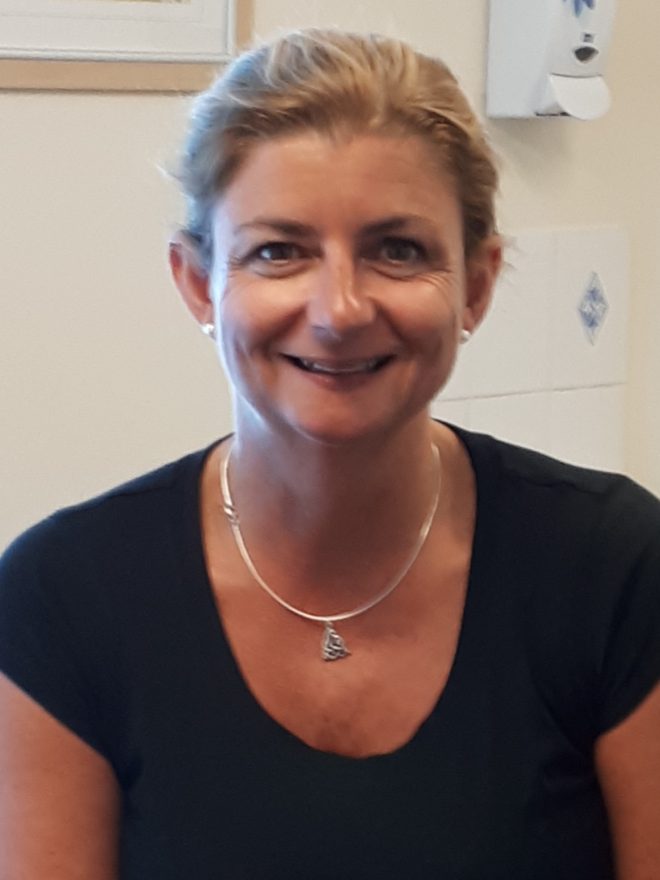
Clinic News
We start the month by saying good luck to Jenny as she starts her maternity leave and look forward to welcoming her little one in due course. Wendy MacDonald will be caring for Jenny’s patients until her return next year.
We now have full installation and registration of the defibrillator which proudly stands on Queens Road.
Andrew’s been busy on a course in Edinburgh discovering new methods to treat various problems from hips to jaws. Sophie got a new PB in her Long Eaton Park run and Alex takes the stage at the Pregnancy and Paediatric Symposium in London where she presented to delegates information about Child Safeguarding, NHS breast feeding pathways and Biological Nurturing. She joined an esteemed line up of international paediatric chiropractic speakers who were presenting on the role chiropractors have in supporting breast feeding.

Monthly challenge: Balance
Balance is important throughout life and in our more elderly population poor balance can lead to falls which increase the risk of breaking a hip and losing mobility/independence as a result.
Please make sure you attempt the challenge in a safe environment!
Ø Firstly stand on one leg.
How good are you? Are your arms moving to keep your balance? Does staring at one spot help?
Ø Next try standing on the other leg.
How does it compare? Is one side easier than the other?
For each of the next progressions try it first standing on one leg and then compare it to standing on the other leg. Only progress this challenge when you can do the previous step comfortably.
Ø Try closing your eyes.
Ø Try turning your head left and right (eyes open).
Ø Try turning your head with your eyes closed.
Ø Try standing on one leg with something small under your big toe (a stone/pencil/etc)
Ø Try standing on one leg with a cushion under the entire foot.
Ø Try all the above holding your right arm out, then try again with the left arm.
Your eyes, ears, neck, ankle and big toe are all key contributors to your balance. If you are having issues with these challenges chat to the chiropractor –they will see what they can do to help.

Back Pain During a Flight
With the summer in full swing, it is likely that you will be planning an overseas holiday at some point. Flying is usually the worst part of any holiday, but for some people, it can be excruciating. If you already suffer from back pain then a long haul flight can make matters a lot worse.

A substantial 88 per cent of people experience increased back or neck pain following a flight, according to a survey by Spine Universe. With limited movement, long periods of time spent sitting down and cramped seating areas, it is hardly surprising that so many people suffer.
However, don’t let flying ruin your holiday. Here are some ways to ease, manage and possibly prevent back pain once you’ve taken to the skies.
Firstly, try to get up and move regularly when flying. Sitting for too long in the same position can cause stiffness and pain. Therefore try requesting an aisle seat, from the airline, so you can stand up easily, without constantly disturbing others – especially if it’s during a nighttime flight. You can also try to do some simple stretches at the back of the plane if possible. If this isn’t possible you can do some stretching in your seat. Neck rolls, rolling your shoulders back and forth or raising your hands as high above your head as possible are good ideas. The most important thing is you keep your body moving every now and then so your muscles don’t spasm and seize up.
Before a flight, you should try to pack as light as possible. A small backpack that distributes weight evenly can also help once you’re at the destination. Think twice about packing unnecessary items, do you really need your tablet, extra clothes etc. for a day trip?
Finally we suggest investing in anything that might help to decrease the pain. Lumbar pillows, seat cushions and heating pads are all useful. Test out any new products before your trip, you don’t want to waste your time by taking something that doesn’t work properly. It is also wise to bring a few extra days worth of medication, if you’re on any, in case there are any flight delays or other unexpected circumstances.
If you’re worried about your back while flying make sure to contact the airline as they are likely to have some advice and be aware of making sure you’re comfortable when you’re on board. Most importantly – make sure to enjoy your holiday.

Keeping Technology Healthy for Teens
Teenagers can be at risk from suffering back or neck pain due to sedentary lifestyles and the excessive use of technology.
Findings from the British Chiropractic Association (BCA) show that 40% of 11 to 16 year olds in the UK have experienced back or neck pain. More than one in seven (15%) parents said their son’s or daughter’s pain is a result of using a laptop, tablet or computer.
The research revealed that almost three quarters (68%) of 11 to 16 year olds spend between one and four hours a day on a laptop, tablet or computer and 73% spend between one and six hours on the devices. More than a third (38%) of parents said their child spends between one and six hours a day on their mobile phone.
Chiropractors are now noticing a rise in the number of young people presenting with neck and back problems due to their lifestyle choices. Today, the BCA is encouraging parents to limit the time their children spend using technology and instead encourage more active pastimes over the Summer holidays.
Based on a two hour period, young people spend more time on games consoles (33%) than doing an activity like riding a bicycle (12%). When asked how much time their teenager spends on their bicycle, one in five (21%) parents admitted that they don’t have one.
Nearly half (46%) of parents questioned, acknowledged that their children don’t spend enough time exercising, despite NHS guidelines stating that children and young people between 5 and 18 years old need to do at least one hour of physical activity every day.
More people under the age of sixteen are being seen with back and neck pain, and technology is so often the cause. Young people are becoming increasingly sedentary which is damaging their posture. There is the tendency to sit in a hunched position when working on computers and laptops, putting a lot of strain on the neck.
Learning how to sit properly and keeping active will help to keep young people healthy and pain free. It’s important that parents seek help for their children from an expert as soon as any pain starts – if conditions are left untreated it could lead to chronic back and neck problems in later life.
The BCA offers the following top tips for parents to help their teenagers reduce the risks of back and neck pain:
- Get your kids moving: The fitter children are, the more their backs can withstand periods of sitting still. To increase fitness levels, your child should be more active which can be achieved by doing activities including walking to school, riding a bike or going for a run.
- Teach them how to sit: It’s important that children learn the correct way to sit when they’re using a computer. Teach them to keep their arms relaxed and close to their body and place arms on the desk when typing. Make sure the top of the screen is level with the eyebrows and the chair is titled slightly forward, allowing for the knees to be lower than the hips and the feet to be flat on the floor. Using a laptop or tablet away from a desk will encourage poor posture, so limit time spent in this way.
- Don’t sit still for too long: Make sure children take a break from the position they’re sitting in on a regular basis and stretch their arms, shrug their shoulders and move their fingers around – this helps to keep the muscles more relaxed.
- Lead by example: Maintaining good posture and promoting good back health is something that everyone should be doing, adults and children alike. If you make it a priority, it’s easier for your children to see the relevance.
- Seek medical advice: Seek professional advice if your child is experiencing pain which has lasted for more than a few days. If your child wants to be more active, check that there are no medical reasons why they should not exercise, particularly if they are not normally physically active.

Change Your Diet To Minimise Osteoporosis Risk
As lifestyle changes in the 21st century make the condition of osteoporosis ever more prevalent, it becomes a threat that you should take into consideration.
The ageing population, dietary trends such as dairy intolerance and the increase in eating disorders like anorexia all contribute to the growing numbers of sufferers. Today’s indoor lifestyle is also a factor, since a lack of vitamin D from the sun hinders your absorption of dietary calcium.
The frightening part of this condition is that it is sometimes not diagnosed until a bone is broken. A way to assess your risk of fracture is a bone density scan. This is the most accurate way of measuring the strength of bones. This scan can be organised through your GP or private clinics, and then appropriate advice can be given by your GP or chiropractor.
There are precautions we can all take to minimise the threat of osteoporosis to our physical health and mobility, both by medical and natural means.
A nutritious diet, and taking supplements where need be, is of paramount importance. If you’re vegan or don’t consume dairy products for other reasons, it’s important to find an alternative source of calcium in your diet. Leafy greens or tinned, soft-bone fish such as salmon or sardines are great options. It’s important to be aware that some foods make it harder to absorb calcium, such as carbonated drinks.
To help your body absorb calcium, vitamin D is essential. As well as synthesizing this from the sun’s UVB rays, oily fish such as salmon, mackerel and sardines provide some vitamin D. However, especially in the UK, vitamin D supplements are recommended.
Another key nutrient for bone health is magnesium. While this mineral contributes to many functions in the body from nerve function to immune health, it is primarily found in bone crystals, contributing to their strength. Magnesium is often included in calcium supplements.
Vitamin C plays an important role too. Collagen is the main protein in bone, and Vitamin C is necessary for collagen synthesis. Vitamin C is present in citrus fruits, tomatoes, and in many vegetables.
Chiropractors are fully qualified manipulative practitioners who diagnose and treat disorders of bones, as well as muscles, joints, ligaments and tendons. Your chiropractor will give you specific advice on how to strengthen your skeleton and minimise your risk.






